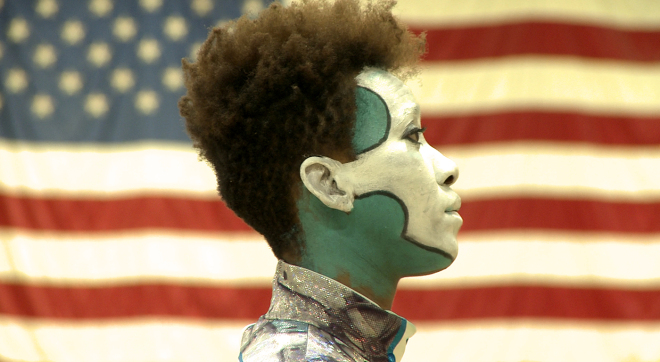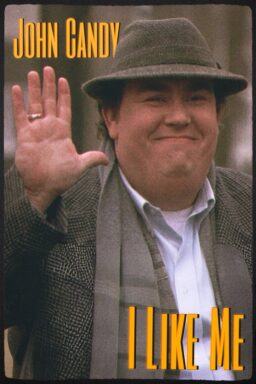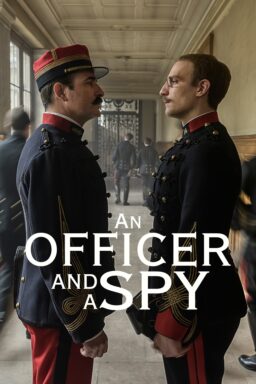Two documentaries premiered at this year’s Tribeca Film
Festival that open windows into unique forms of expression. Richard Dewey and
Timothy Marrinan’s “Burden” chronicles the history of the very rare performance
artist Chris Burden, even including the chapter in which Roger Ebert reported
on an installation he performed in Chicago. The Ross brothers’ “Contemporary
Color” takes us behind the scenes of a once-in-a-lifetime color guard
performance, set to music by Nelly Furtado, Ad-Rock, David Byrne, Nico Mulhy &
Ira Glass and many more. Both are interesting films, although “Burden” is
largely more so just for the fascinating subject it chronicles. “Contemporary
Color” is joyous and masterful no matter what angle one looks at it from.
Let’s start there. When David Byrne was asked by a color guard
if they could use one of his songs, he looked deeper into what they wanted it
for, becoming fascinating by the choreography of dancers that’s usually only
seen at halftime shows. He created a traveling show called “Contemporary Color,”
in which ten color guard troupes perform in front of live musical
accompaniment. The result is a mesmerizing blend of music and motion, captured
in a unique fashion by the men behind “45365” and “Western.”
The Ross brothers are clearly interested in Americana and the
trajectories of everyday life, and so they bring some of that sensibility to “Contemporary
Color.” Let’s be honest—nearly anyone could shoot these accomplished dancers
and musicians in a concert-film style and it would be visually engaging. It’s
hard to screw up St. Vincent. However, their approach is distinct. At times,
they take on the role of an observer, shooting between-performance video
segments from the audience (video of video instead of just editing in the
footage of what the audience saw) or chasing people down the hallways back
stage. They’ll capture the “announcer” interviewing Byrne but not interview him
straight to camera themselves. And they’re refreshingly uninterested in star
value, regularly cutting from the stage to the next group of young people
nervously waiting their turn.
And yet they also frame the actual performances beautifully,
in no small part because the camera operators included Sean Price Williams (“Queen
of Earth”), Robert Greene (“Kate Plays Christine”) and Amanda Wilder (“Approaching
the Elephant”). There’s a hypnotic rhythm to the film that alternates between
wide shots that allow us to see the whole performance (and musical performer)
and close-ups of bodies moving in unison. It’s fluid, beautiful camerawork,
never too close to the groups to blur the larger picture but also not afraid of
a slo-mo close-up.
There’s also a deep humanism at the core of “Contemporary
Color.” For all ten of these troupes, it’s the last time they will perform
these numbers (which the musicians created original music for, not the other
way around). Luckily for them, they have been captured forever in a truly great
movie.

If the Ross brothers’ deftly enhance the experience of their
subject, the directors of “Burden” wisely know to simply get out of the way.
Chris Burden’s story is crazy enough; a movie about him doesn’t need a lot of
artistic imprint. Roger Ebert himself was fascinated by Burden,
writing about him here and here. If you’re not familiar, Burden was a popular
performance artist in the ‘70s, a man who often turned his own body into part
of the art. For example, in his most famous piece, he was shot in the arm. He
argued that the actual minute the bullet entered his arm was art. In another
piece, he staged a show in Chicago, not telling anyone what it would be or how
long it would last. There was a clock and a pane of glass. Burden laid down
under the glass. And didn’t move. Audiences left. Days went by. It was art.
Richard Dewey and Timothy Marrinan’s “Burden” is a
relatively direct piece of biographical filmmaking. They seem extra careful not
to place too much judgment on a man whose work became increasingly incendiary
and even damaging to those around him. The result broaches hagiography a bit,
such as when Burden had an affair and then turned it into an art piece called “The
Confession,” in which his wife found about the infidelity along with everyone
else and it’s treated as “Well, that was Chris.” They get into more of the difficulty
of knowing and working with Chris Burden as the piece goes along, but there’s a
bit too much pedestal placement before we get there.
I love people who question not only the purpose but the
delivery of art. As someone says in “Burden,” “What if art was painful? What if
it scared the shit out of you?” Not all art needs to be safe and predictable.
Both “Burden” and “Contemporary Color” capture artists doing something
undeniably unique, approaching music, performance, and art from a perspective
distinctly their own. What do David Byrne and Chris Burden have in common other
than the fact that both are artists? Not much, but these two films successfully
argue that their art is enough to make them essential.












